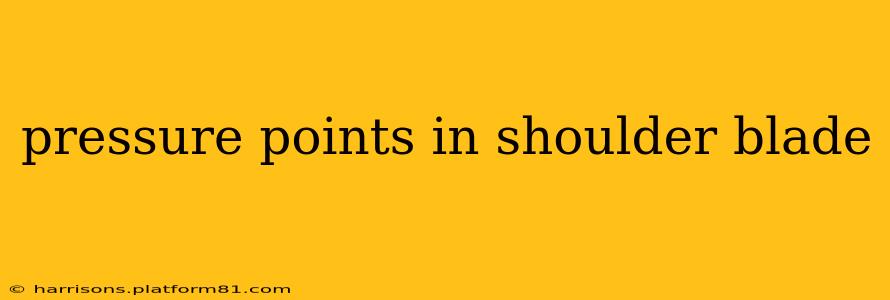Shoulder blade pain, or scapular pain, is a common ailment affecting people of all ages and activity levels. Understanding the potential pressure points and their causes can significantly aid in self-treatment and prevention. This article delves into the intricacies of scapular pain, exploring its causes, identifying key pressure points, and offering effective management strategies.
What Causes Shoulder Blade Pain?
Before we explore specific pressure points, it's crucial to understand the various factors that contribute to shoulder blade pain. The shoulder blade, or scapula, is a complex structure involved in a wide range of movements. Pain can stem from issues within the scapula itself or from referred pain originating elsewhere. Common causes include:
- Muscle Strain or Spasm: Overuse, improper posture, or sudden movements can strain the muscles surrounding the scapula, leading to pain and stiffness. This often manifests as localized tenderness in specific areas.
- Referred Pain: Pain originating from other areas, such as the neck, heart, or even the abdomen, can manifest as pain in the shoulder blade. This is a crucial point to consider, as treating the shoulder blade itself might not resolve the underlying issue.
- Arthritis: Conditions like osteoarthritis or rheumatoid arthritis can affect the joints in the shoulder, including the acromioclavicular (AC) joint, leading to pain and reduced mobility.
- Injury: Direct trauma to the shoulder blade, such as a fall or impact, can cause fractures, dislocations, or soft tissue damage.
- Nerve Compression: Problems with the nerves supplying the shoulder region can cause pain, tingling, or numbness in the shoulder blade area.
- Poor Posture: Prolonged periods of poor posture, especially hunching over a computer or phone, can lead to muscle imbalances and pain.
Identifying Key Pressure Points in the Shoulder Blade
Pinpointing the exact location of pain is crucial for effective treatment. While not strictly "pressure points" in the traditional acupuncture sense, certain areas around the shoulder blade are particularly sensitive when underlying issues exist. These areas often correspond to specific muscle attachments or nerve pathways:
- Between the Shoulder Blades: Pain in this area often indicates muscle strain or spasm in the rhomboid muscles, which stabilize the scapula.
- Inner Edge of the Shoulder Blade (Medial Border): Pain along the inner edge might indicate problems with the serratus anterior muscle, responsible for protracting the scapula (pulling it forward).
- Outer Edge of the Shoulder Blade (Lateral Border): Pain here could indicate issues with the infraspinatus and teres minor muscles, which are rotator cuff muscles crucial for shoulder stability.
- Top of the Shoulder Blade (Superior Angle): Pain in this region may involve the trapezius muscle, responsible for elevating and rotating the scapula.
- Tip of the Shoulder Blade (Inferior Angle): Pain at the bottom of the scapula can indicate issues with the latissimus dorsi muscle or other lower back muscles.
How to Treat Shoulder Blade Pain?
Treatment depends on the underlying cause of the pain. Self-care measures are often effective for mild cases:
- Rest: Avoid activities that aggravate the pain.
- Ice: Applying ice packs for 15-20 minutes at a time can reduce inflammation.
- Heat: After the initial inflammation subsides, heat can help relax tense muscles.
- Stretching and Exercise: Gentle stretches and exercises can improve flexibility and strengthen supporting muscles. Examples include scapular retractions, shoulder blade squeezes, and upper back stretches.
- Over-the-Counter Pain Relief: Nonsteroidal anti-inflammatory drugs (NSAIDs) like ibuprofen can help reduce pain and inflammation.
For persistent or severe pain, consult a healthcare professional. They may recommend further investigation, such as X-rays or MRIs, to determine the cause and recommend appropriate treatment, which could include:
- Physical Therapy: A physical therapist can design a personalized exercise program to strengthen muscles, improve flexibility, and correct posture.
- Massage Therapy: Massage can help relieve muscle tension and improve circulation.
- Medications: Stronger pain relievers or muscle relaxants may be prescribed for more severe pain.
- Injections: Corticosteroid injections can help reduce inflammation in the affected area.
- Surgery: In rare cases, surgery may be necessary to address underlying issues such as fractures or severe muscle damage.
What are the common causes of shoulder blade pain?
As discussed above, common causes of shoulder blade pain include muscle strain or spasm, referred pain, arthritis, injury, nerve compression, and poor posture. It's essential to determine the root cause for effective treatment.
Is shoulder blade pain a sign of a heart attack?
While shoulder blade pain can be a symptom of a heart attack, especially in women, it's not always indicative of cardiac issues. Other symptoms, such as chest pain, shortness of breath, and nausea, are more commonly associated with heart attacks. If you experience sudden, severe chest pain or discomfort accompanied by shoulder blade pain, seek immediate medical attention.
What stretches can help relieve shoulder blade pain?
Several stretches can alleviate shoulder blade pain. These include:
- Scapular Retractions: Squeeze your shoulder blades together and hold for a few seconds. Repeat several times.
- Shoulder Blade Squeezes: Sit upright and squeeze a foam roller or small pillow between your shoulder blades. Hold for several seconds.
- Upper Trapezius Stretch: Gently tilt your head to one side, bringing your ear towards your shoulder. Hold for several seconds and repeat on the other side.
- Cross-Body Shoulder Stretch: Reach one arm across your body and gently pull it towards your chest with your other hand.
Remember, this information is for general knowledge and does not constitute medical advice. Always consult a healthcare professional for diagnosis and treatment of any medical condition. Proper diagnosis and treatment are crucial for effective pain management and preventing future problems.
